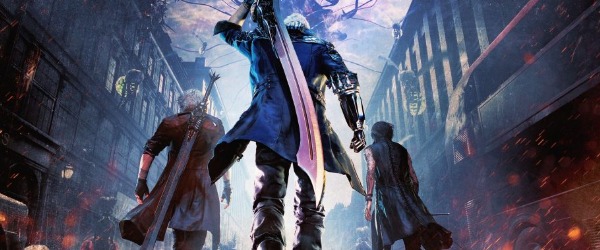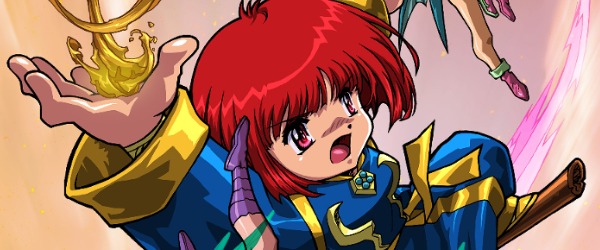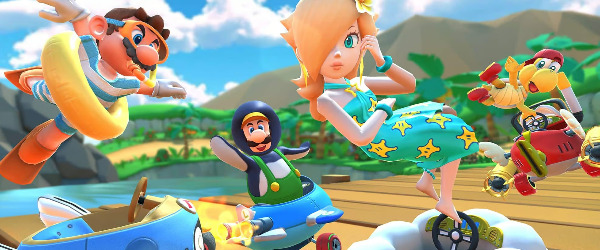
gamrReview Japan: A Night at Namco Land - Article
by VGChartz Staff , posted on 02 March 2015 / 4,422 ViewsVideo arcades peaked in popularity in the West in the 80s and were all but gone with the arrival of the new millennium. That is not the case in Japan where arcades, or game centers, remain a vital part of gaming culture. Whenever a high profile new arcade game is announced, western gamers take to the internet hoping for a localization and console port, whereas here in Japan it is just a matter of wondering when said title will arrive at the arcade down the street.

Such is the case with the recently announced and demoed Pokken Tournament and Dissida Final Fantasy arcade games. While those arcade machines have yet to be unleashed, I decided to pop in to my local Namco Land Game Center to try out some arcade games that are available to play right now.
Taiko Drum Master
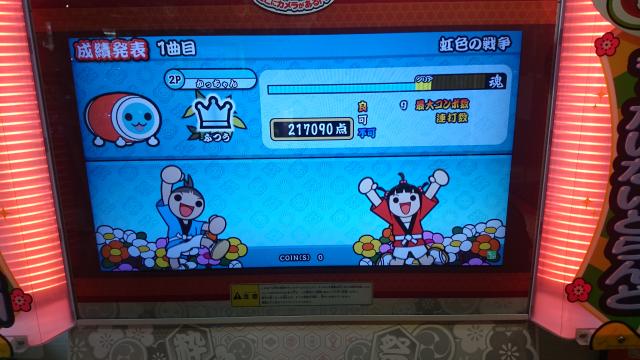
Taiko drumming is a cultural cornerstone of Japanese history, and Taiko Drum Master is one of the more popular arcade staples. It is exceedingly rare to visit a game center without at least one Taiko station in it. Though I am rhythmically challenged, Taiko Drum Master is one of my favorite arcade games, thanks to its pick up and play nature and at times intense physical demands. The station comes with two drums, each tethered to a pair of drum sticks.
After inserting your 100 yen you interact with the game completely by drumming; striking the left or right side of the drumhead to scroll through menu items and striking in the center to confirm your choice. At times there is a counter in the corner of the screen counting down until it will automatically move onto the next screen. You can speed up this counter by drumming swiftly.

There's a wide variety of tracks to drum along to, and they're separated into categories such a Game, J-Pop, Classical, Anime, etc. The first track I chose was a medley of tracks from Pokemon X & Y. The stream of notes comes in several varieties. Red notes are straightforward strikes, light-blue notes require you to strike the side or the rim of the drum. Big red notes are cues for a powerful strike of the drum with both sticks. Finally, an elongated note is the signal for a drum roll. Naturally, the game tells you if you hit a note perfectly, passably, or not at all, with a meter at the top of the screen gradually filling up as you hit the right beats.
There are different thresholds to clear to pass the level, achieve a high score, and perfectly hit all of the notes. Sadly, I failed to get a passing grade on the Pokemon song but was determined to try again. My next track selection was “虹色の戦争“ by the popular Japanese band Sekai no Owari. I did much better this time around, perhaps because I knew the song beforehand.
Wagan Midnight 5

Wagan Midnight 5 is a popular arcade street racer from Namco Bandai. I dared to get behind the wheel of the series’ latest iteration - Wagan Midnight 5 Maximum Tune - which was sporting a “2014 10 update.” I decided to play through a few races of the game's story mode at the price of 100 yen per race. I selected a blue Nissan Skyline GTR. As far as the story goes, Japanese text appears over hand drawn 2D images, akin to what you would see in a manga. I did not pay much attention to what was going on but could ascertain that someone had challenged me to a race on the streets of Tokyo. At this point I encountered two elements I am unaccustomed to as an American driver: manual transmission and driving on the opposite side of the road.
Once the race started I quickly shifted up through the gears until I achieved max speed in 6th gear and had no reason to shift down again for the duration of the race. Winning was just a matter of accelerating and weaving through traffic. Because the race was not on a closed course most of it took place on straightaways. Once I overtook my main rival, a surprise challenger appeared and outclassed me to the finish line by some margin. I only had to beat the original opponent, however, in order to be declared victorious. For winning I was allowed to upgrade my car’s horsepower a bit, and for another 100 yean I could continue on to the next story chapter.

The next race was a night time sprint in Yokohama against a suave driver in a white Ferrari. The result was similar to that of the race before, with me overtaking the original opponent but subsequently being left in the dust of another mystery driver. The AI cars and trucks that populate the streets are all yellow, which helps you to distinguish them from the car you are racing against. Graphically, Wagan Midnight 5 underwhelms, with boxy visuals and jaggies galore. However, despite its simplicity and less than stellar presentation, Waggan Midnight 5 has an enjoyably nostalgic slant to its racing, although at the cost of 100 yen per race it's also pretty pricey. In the end my need for speed just wasn’t strong enough to warrant a third race.
Dragonball Z Zenkai Battle Royale
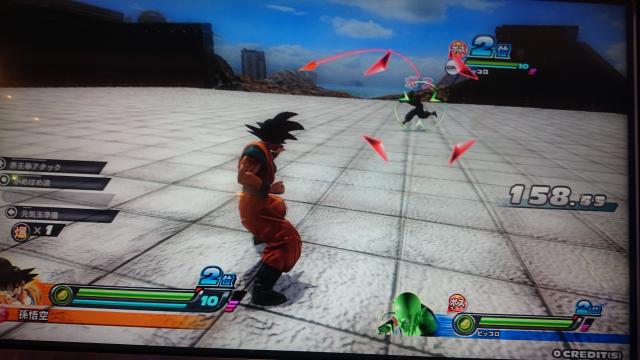
Dragon Ball Z Zenkai Battle Royale is a 3D brawler where up to 4 players can compete in the ultimate fight for arcade glory. Playing the game for the first time, I learned the ropes by going through the tutorial, which explained the game’s five-button layout fairly well. One button fires a single energy blast, another button controls melee attacks, a third is used to jump and fly, another is used to guard against enemy attack, and the final button allows you to change targets. Set button combinations can be used to execute special moves, such as the Kamehameha.
I had the chance to fight as Goku, young Gohan, Piccolo, and Krillen in four fights of the game’s story mode. You play the game from a behind-the-back 3rd person view. Some fights have you taking on multiple AI opponents at the same time while others give you an ally to combined your efforts with and take down an especially powerful enemy. The large 3D environments are destructible, allowing you to level mountains and other colossal structures by smashing your foes into them. Each fighter has 2 health bars, and once the first one is depleted the combatant eats a senzu bean to revive. Rewards for winning individual fights include new wardrobe items to customize your preferred fighter.

Visually, Dragonball Z Zenkai Battle Royale looks similar to most recent (non-cel-shaded) 3D games in the series, though with many visible rough edges.
DragonBall Z Zenkai Battle Royale gives you a lot of playtime for your 100 yen coin; my session clocked in at over 30 minutes before I was prompted to insert another coin. The fights can become intense and go down to the wire, and I freely admit to resorting to button mashing in desperate situations. When no one is playing the game the cabinet displays a trailer for the upcoming Dragon Ball Z movie, featuring the return of Frieza.

There are ways to save your progress with the game, using a special arcade card so that you can continue through the game’s lengthy story mode and carry your custom fighters to any local arcade and continue leveling them up. The game did not hook me to quite that extent but it was certainly a fun diversion.
Ultra Street Fighter IV

No visit to an arcade is complete without a rendezvous with the latest iteration of Street Fighter. In this case Ultra Street Fighter IV was the cabinet to satisfy my 2D fighting fix. Four arcade machines were huddle together to facilitate local 1-vs-1 matches, though I had no such luck in participating in one during my time at the arcade. Instead, I jumped right in to the arcade mode, choosing my old standby Cammy.
The last time I played Street Fighter IV was when I owned the original console version shortly after its release. Needless to say SFIV has since seen multiple new additions and revisions that have brought about gameplay changes, additional stages, and new characters — all of which are too much for a less than casual player like myself to absorb in one sitting. The most noticeable and welcomed change for me personally was the Japanese voiceovers for all of the characters.
As Cammy I was able to Spiral Arrow my way to victory against Adon and Sakure. Unfortunately I lost to the old wrestling stalwart Zangeif by making the rookie mistake of staying too close, leaving me vulnerable to his devastating grappling attacks. Shaking off the veneer of defeat I inserted another 100 Yen coin and this time selected to play as Evil Ryu, who plays similarly to regular Ryu, but looks way more badass with a black void where his heart should be. I had more luck as Evil Ryu, making my way through Yang, Guile, Chun-Li, and (by the skin of my teeth) Ken. My luck ran out when I came up against the monstrously massive Hugo, who looks like Howard Stern on every steroid known to mankind, again by falling prey to grabs despite my best attempts to keep a safe hadouken-capable distance.
As Cammy I was able to Spiral Arrow my way to victory against Adon and Sakure. Unfortunately I lost to the old wrestling stalwart Zangeif by making the rookie mistake of staying too close, leaving me vulnerable to his devastating grappling attacks. Shaking off the veneer of defeat I inserted another 100 Yen coin and this time selected to play as Evil Ryu, who plays similarly to regular Ryu, but looks way more badass with a black void where his heart should be. I had more luck as Evil Ryu, making my way through Yang, Guile, Chun-Li, and (by the skin of my teeth) Ken. My luck ran out when I came up against the monstrously massive Hugo, who looks like Howard Stern on every steroid known to mankind, again by falling prey to grabs despite my best attempts to keep a safe hadouken-capable distance.

Ultra Street Fighter IV remains a gorgeous game. My fights took place at a skate park, outside a drive-in diner, in a South American Jungle, and outside of a secret Jurassic research facility. I know Ultra Street Fighter IV is already available on home consoles and there may even be a number of arcade cabinets found on western shores, but I still got a kick out of playing it in a dark, smoky Japanese arcade. Though I am undeniably a noob, I think I fought valiantly for someone more used to playing with a DualShock rather than a joystick and 6 button arcade combo.
Gundam Extreme Vs. Maxi Boost

Gundam Extreme Vs. Maxi Boost actually plays a lot like the Dragon Ball Z game I described above except it has a simple 4 button layout. This game is also a 3D brawler where you shoot, jump, and melee your way through a series of fights loosely linked by a story mode from the source anime’s lengthy history. Your health in the game is represented by the number 660, but if it is depleted by an enemy Gundam mid-fight you have another life to redeem yourself. You almost always have a partner to assist you in defeating the giant enemy robots, and they actually saved me from utter destruction on more than one occasion.

Graphically, Gundam Extreme Vs. Maxi Boost captures the look of the anime well, though in motion the game looks a bit stiff and sterile. The visual highlights are the destructible 3D environments and cool death animations you're treated to when you slice an enemy Gundam in half. The four cabinet configured is set up for both competitive and cooperative play, though again I did not have the chance to sample either one. To be honest I am not a big fan of Gundam in the first place, my arms were sore from so much button mashing, and I just was not having much fun, so I took a dive and let the AI destroy me after my fifth fight. I regret nothing.
Namco Land is actually one of the smallest game centers I’ve visited since living in Japan. The absence of a Tekken game was disappointing considering it is perhaps Namco’s premiere arcade series, but regardless I had a few hours of relatively inexpensive fun and look forward to visiting again soon and often.








